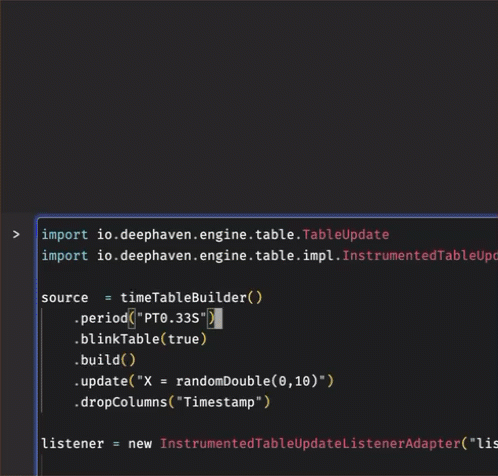Listen to ticking tables
Deephaven makes it easy to create dynamic queries that update in real time. When a table updates, a message describing the changes is sent to all listeners of the table. This mechanism is what makes ticking queries work. It can also be used to create new, dynamic functionality.
As an example, consider using a Deephaven query to create a dynamic table that monitors for situations needing human intervention. You can create a table listener that sends a Slack message every time one or more tables tick. Similarly, you could have a table of orders to buy or sell stocks. If rows are added to the order table, new orders are sent to the broker, and if rows are removed from the order table, orders are canceled with the broker.
This guide will show you how to create your own table listeners in Groovy.
What is a table listener?
A table listener is an object that listens to one or more tables for updates. When connected to a ticking table, a listener receives one or more TableUpdate objects that can be used to access the added, modified, or removed data.
Listen to one ticking table
To listen to a table, add an instance of the listener to the table with the Table.addUpdateListener(listener) method. Once a listener is registered, it will begin receiving updates. To control what the listener does upon receiving an update, override the listener's onUpdate method.
In this simple example, the listener will keep track of how many times it has been called.
import io.deephaven.engine.table.TableUpdate
import io.deephaven.engine.table.impl.InstrumentedTableUpdateListenerAdapter
t1 = timeTable("PT1S").update("X=i").tail(5)
h1 = new InstrumentedTableUpdateListenerAdapter(t1, false) {
def counter = 0
@Override
public void onUpdate(TableUpdate upstream) {
println "FUNCTION LISTENER: counter=${++counter} update=${upstream}"
}
}
t1.addUpdateListener(h1)
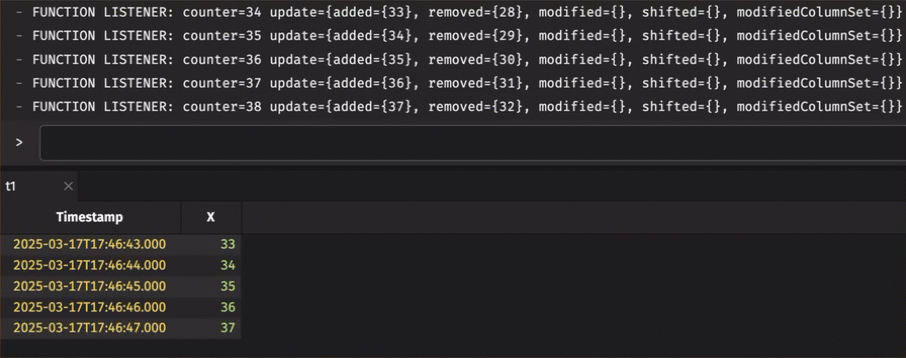
Listen to multiple ticking tables
To listen to more than one table at once, you will need to use a MergedListener. Once a listener is registered, it will begin receiving updates.
A MergedListener takes four inputs:
recorders: an iterable set ofListenerRecorderinstances.dependencies: An iterable set of dependencies (such as other Tables) for theMergedListener.listenerDescription: A String description of the listener.result: a result table that uses the listener's tables as sources. Can be null.
The following example listens to two time tables, one ticking every two seconds and the other ticking every three seconds. getUpdate() returns a TableUpdate object for each ListenerRecorder, and the MergedListener's process function is overwritten to print updates if they have been received and to do nothing otherwise.
import io.deephaven.engine.table.TableUpdate
import io.deephaven.engine.table.impl.ListenerRecorder
import io.deephaven.engine.table.impl.MergedListener
t1 = timeTable("PT1S").update("X=i").tail(5)
t2 = timeTable("PT2S").update("X=i*2").tail(5)
recorder1 = new ListenerRecorder("t1", t1, null)
recorder2 = new ListenerRecorder("t2", t2, null)
h = new MergedListener([recorder1, recorder2], [], "Description", null) {
def counter = 0
@Override
void process() {
counter++
tu1 = recorder1.getUpdate()
tu2 = recorder2.getUpdate()
colSrc1 = t1.getColumnSource("Timestamp")
colSrc2 = t1.getColumnSource("X")
colSrc3 = t2.getColumnSource("Timestamp")
colSrc4 = t2.getColumnSource("X")
if (tu1 != null) {
it1 = tu1.added().iterator()
while (it1.hasNext()) {
col1Data = DateTimeUtils.epochNanosToInstant(colSrc1.getLong(it1.next()))
col1Type = colSrc1.getType()
col2Data = colSrc2.getInt(it1.next())
col2Type = colSrc2.getType()
println "t1 updates: {'Timestamp': [data=${col1Data}, ${col1Type}], 'X': [data=${col2Data}, ${col2Type}]"
}
it1 = null
}
if (tu2 != null) {
it2 = tu2.added().iterator()
while (it2.hasNext()) {
col3Data = DateTimeUtils.epochNanosToInstant(colSrc3.getLong(it2.next()))
col3Type = colSrc3.getType()
col4Data = colSrc4.getInt(it2.next())
col4Type = colSrc4.getType()
println "t2 updates: {'Timestamp': [data=${col3Data}, ${col3Type}], 'X': [data=${col4Data}, ${col4Type}]"
}
it2 = null
}
}
}
recorder1.setMergedListener(h)
recorder2.setMergedListener(h)
t1.addUpdateListener(recorder1)
t2.addUpdateListener(recorder2)
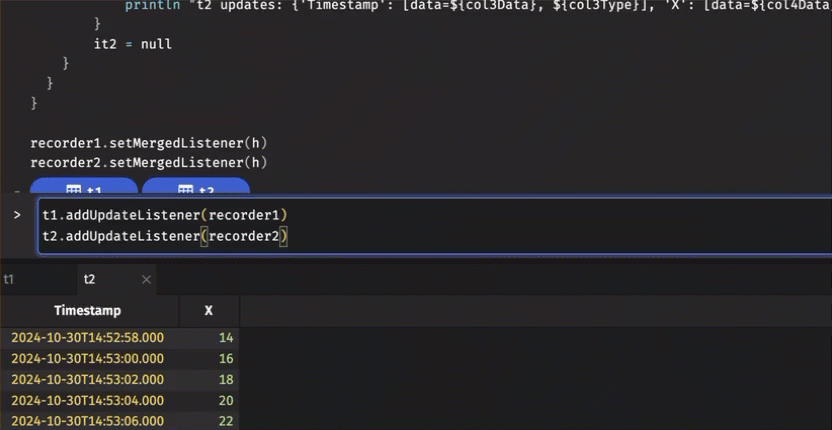
Important
updates contains null values for any table that has not changed during the update cycle. These null values must be handled to avoid raising errors.
Access table data
A TableUpdate object contains the added, modified, and removed rows from a table. There are several ways to access this data.
The following methods return a RowSet of the added, removed, or modified data:
acquire- Increments the reference count for the update.added- rows added during the current update cycle.modified- rows modified during the current update cycle.removed- rows removed during the current update cycle.getModifiedPreShift- rows modified during the previous update cycle.
The following example listens to added rows during each update cycle. It prints the data as the listener receives it.
import io.deephaven.engine.table.TableUpdate
import io.deephaven.engine.table.impl.InstrumentedTableUpdateListenerAdapter
t1 = timeTable("PT1S").update("X=100+i").tail(5)
h1 = new InstrumentedTableUpdateListenerAdapter(t1, false) {
def counter = 0
@Override
public void onUpdate(TableUpdate upstream) {
it1 = upstream.added().iterator()
colSrc1 = t1.getColumnSource("Timestamp")
colSrc2 = t1.getColumnSource("X")
while (it1.hasNext()) {
it = it1.next()
col1data = DateTimeUtils.epochNanosToInstant(colSrc1.getLong(it))
col1type = colSrc1.getType()
col2data = colSrc2.getInt(it)
col2type = colSrc2.getType()
println "{'Timestamp': [data=${col1data}, type=${col1type}], 'X': [data=${col2data}, type=${col2type}]}"
}
}
}
t1.addUpdateListener(h1)
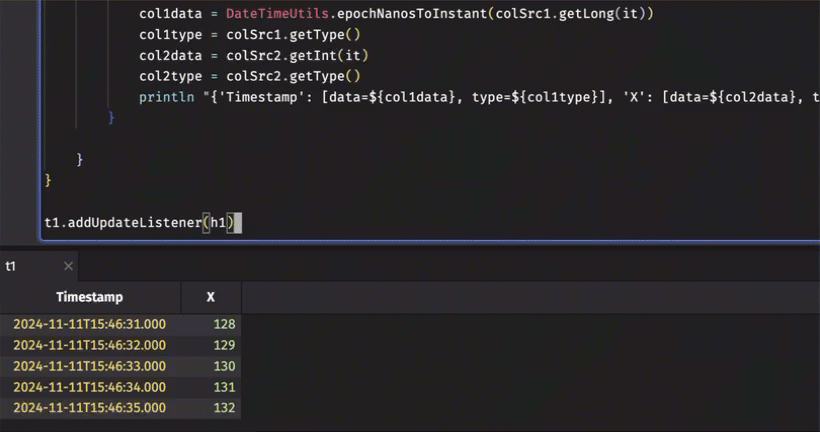
The following example listens to modified rows during each update cycle. It uses a RowSet.Iterator to print the current and previous values of the modified rows for the X column.
import io.deephaven.engine.table.TableUpdate
import io.deephaven.engine.table.impl.InstrumentedTableUpdateListenerAdapter
t1 = timeTable("PT0.1s").update("X = i").lastBy()
h1 = new InstrumentedTableUpdateListenerAdapter("listener", t1, null) {
@Override
public void onUpdate(TableUpdate upstream) {
prevModified = upstream.getModifiedPreShift()
currModified = upstream.modified()
if (prevModified.size() == 0) {
println "No previous values"
return
}
xCol = t1.getColumnSource("X")
prevIt = prevModified.iterator()
currIt = currModified.iterator()
while (prevIt.hasNext() && currIt.hasNext()) {
prevRowIdx = prevIt.next()
currRowIdx = currIt.next()
prev = xCol.getPrevInt(prevRowIdx)
curr = xCol.getInt(currRowIdx)
println "Change previous=${prev} current=${curr}"
}
}
}
t1.addUpdateListener(h1)
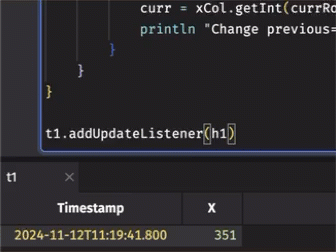
Add and remove listeners
Most applications that require the use of a table listener do so for the entirety of the application's lifetime. If a listener should only be registered for a specified period of time, a listener can be removed from a table using the Table.removeUpdateListener(listener) method.
The following example uses java.util.Timer to remove a listener after 3 seconds and then adds it back it after 6 seconds.
import io.deephaven.engine.table.TableUpdate
import io.deephaven.engine.table.impl.InstrumentedTableUpdateListenerAdapter
import io.deephaven.engine.context.ExecutionContext;
class ExampleListener extends InstrumentedTableUpdateListenerAdapter {
ExampleListener(String description, Table source, boolean retain) {
super(description, source, retain)
}
@Override
void onUpdate(TableUpdate upstream) {
println "FUNCTION LISTENER: update=${upstream}"
}
}
// Use an update graph lock to ensure that the listener does not miss the first updates to the table
ExecutionContext.getContext().getUpdateGraph().exclusiveLock().doLocked(() -> {
t = timeTable("PT1s").update("X=i").tail(5)
listener = new ExampleListener("Test Listener", t, true)
println "Adding listener"
t.addUpdateListener(listener)
});
new Timer().runAfter(3000) {
println "Removing listener"
t.removeUpdateListener(listener)
}
// Use an update graph lock to ensure that the listener does not miss updates during the 6-second wait
ExecutionContext.getContext().getUpdateGraph().exclusiveLock().doLocked(() -> {
new Timer().runAfter(6000) {
println "Adding listener"
t.addUpdateListener(listener)
}
});

Error handling
Use a try-catch block within the onUpdate call to define and handle errors when using table listeners.
Consider an example where a listener raises an error if it receives a value greater than 10. A try-catch block prints a message about the error to the console.
import io.deephaven.engine.table.TableUpdate
import io.deephaven.engine.table.impl.InstrumentedTableUpdateListenerAdapter
source = timeTableBuilder()
.period("PT0.33S")
.blinkTable(true)
.build()
.update("X = randomDouble(0,10)")
.dropColumns("Timestamp")
listener = new InstrumentedTableUpdateListenerAdapter("listener", source, false) {
@Override
void onUpdate(TableUpdate upstream) {
try {
def added = upstream.added()
if (added == null || added.isEmpty()) {
return
}
if (added.any{element -> element > 9}) {
throw new Exception("Number exceeds 9")
}
} catch (Exception e) {
println "${e}"
}
}
}
source.addUpdateListener(listener)

Reduce data volumes
Tables often tick at high frequencies and with large quantities of incoming data. It's best practice to only listen to what's required for an operation. In such cases, applying filters and/or reducing tick frequencies will reduce both the quantity and frequency of incoming data to a listener.
The following example listens to a table that has been filtered and had its tick frequency reduced to reduce the rate at which the listener receives data.
import io.deephaven.engine.table.TableUpdate
import io.deephaven.engine.table.impl.InstrumentedTableUpdateListenerAdapter
t1 = timeTable("PT1S").update("X=i").tail(5)
h1 = new InstrumentedTableUpdateListenerAdapter(t1, false) {
def counter = 0
@Override
public void onUpdate(TableUpdate upstream) {
println "FUNCTION LISTENER for even values: update= ${upstream}"
}
}
source = timeTable("PT0.5s").update("X=i").tail(5)
trigger = timeTable("PT2s").renameColumns("DateTime = Timestamp")
result = source.where("X % 2 = 0").snapshotWhen(trigger)
result.addUpdateListener(h1)
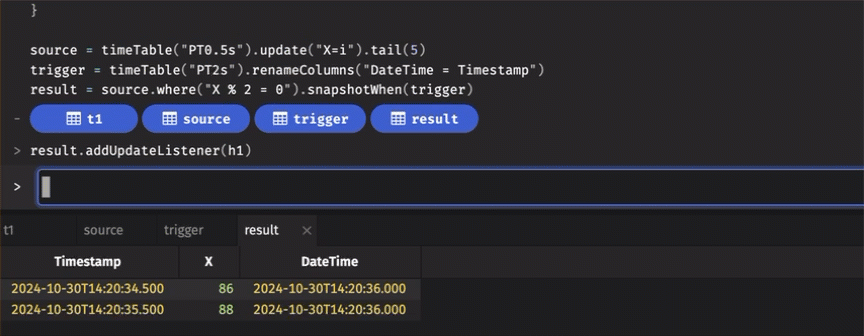
Replay data
A table listener can listen to data that existed before the listener was registered. For example, a listener that isn't registered until 10 seconds after a table starts ticking can be made to listen to the data that was created during those 10 seconds.
To make a listener listen to previously existing data, set the replayInitialImage parameter to true when calling addUpdateListener.
The following example registers two listeners with a time table a few seconds after it's created. Only the one that sets replayInitialImage to True receives data when it's first registered.
import io.deephaven.engine.table.TableUpdate
import io.deephaven.engine.table.impl.ShiftObliviousInstrumentedListenerAdapter
source = timeTable("PT0.3s").update("X = i")
listener = new ShiftObliviousInstrumentedListenerAdapter("LISTENER", source, false) {
@Override
void onUpdate(RowSet added, RowSet removed, RowSet modified) {
println "FUNCTION LISTENER for even values: update={added=${added}, removed=${removed}, modified=${modified}}"
}
}
//Wait a few seconds, and then run the next two code blocks independently
// Set replayInitialImage=false to begin receiving updates on the cycle that the listener is added
source.addUpdateListener(listener, false)
source.removeUpdateListener(listener)
// Set replayInitialImage=true to replay data that existed in the table before the listener was added
source.addUpdateListener(listener, true)
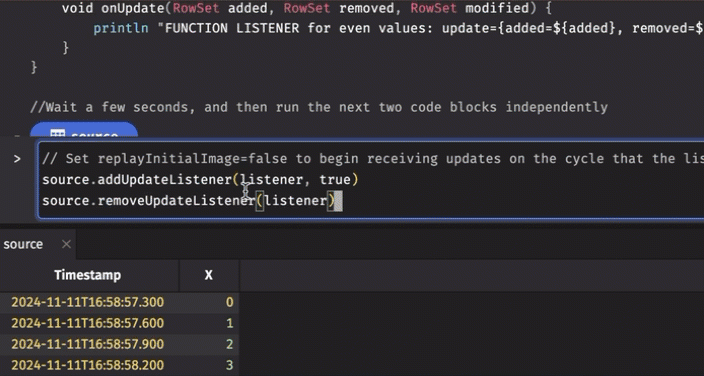
Dependent tables
Listeners can use data from tables other than the one they are listening to if the additional tables are configured as dependencies. When one or more tables are listed as a dependency to a listener, the query engine will wait to call the listener until all dependent tables have been processed. When a table is not listed as a dependency, it may be in an inconsistent state when accessed.
Warning
Don't do table operations inside the listener. While performing operations on the dependent tables in the listener is safe, it is not recommended because reading or operating on the result tables of those operations may not be safe. It is best to perform the operations on the dependent tables beforehand and then add the result tables as dependencies to the listener so that they can be safely read in it.
For example, consider two tables, sourceA and sourceB, that tick simultaneously but cannot be joined. When listening to sourceA, it is not guaranteed that sourceB will have its updates processed in full before the listener receives the update from sourceA. To guarantee that all data is processed before the listener triggers, sourceB must be registered as a dependency for the listener.
import io.deephaven.engine.table.TableUpdate
import io.deephaven.engine.table.impl.BaseTable.ListenerImpl
def letters = ["A", "B", "C", "D"]
def rng = new Random()
randomLetter = { ->
return letters[rng.nextInt(4)]
}
sourceA = timeTable("PT2s").updateView("X = ii")
sourceB = timeTable("PT5s")
.update("Letter = randomLetter()", "Y = randomDouble(0, 10)")
.dropColumns("Timestamp")
.lastBy("Letter")
listener = new ListenerImpl("listener", sourceA, sourceB) {
@Override
void onUpdate(TableUpdate upstream) {
added = upstream.added()
println "From Source A: ${added}"
dependentData = getDependent().select("Y")
iterator = dependentData.columnIterator("Y")
sourceBdata = ""
while (iterator.hasNext()) {
sourceBdata = sourceBdata + iterator.next() + ", "
}
println "From Source B: ${sourceBdata}"
}
}
sourceA.addUpdateListener(listener)
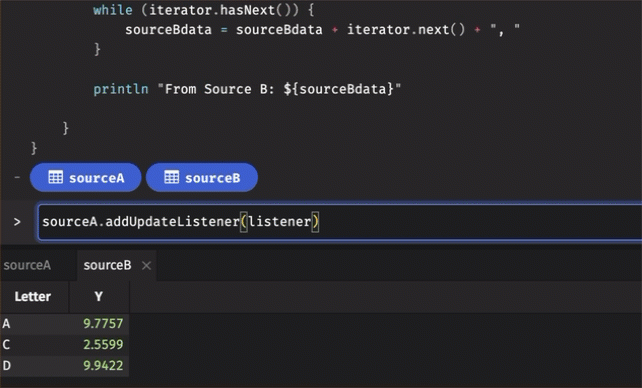
Example
Table listeners are often used to trigger actions based on table updates. For example, a listener could notify Slack or send an email when data meets some criteria. The following example prints values that meet certain criteria. In a real-world use case, rather than print an outlier value, a notification could be sent to relevant parties via email, Slack, Discord, or other service.
import io.deephaven.engine.table.TableUpdate
import io.deephaven.engine.table.impl.InstrumentedTableUpdateListenerAdapter
source = timeTableBuilder()
.period("PT0.33S")
.blinkTable(true)
.build()
.update("X = randomDouble(0,10)")
.dropColumns("Timestamp")
listener = new InstrumentedTableUpdateListenerAdapter("listener", source, false) {
@Override
void onUpdate(TableUpdate upstream) {
added = upstream.added()
if (added == null) {
return
}
if (added.any{element -> element > 9}) {
println "value over 9 detected!"
}
}
}
source.addUpdateListener(listener)
